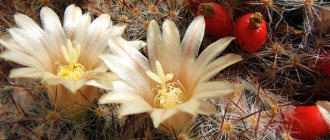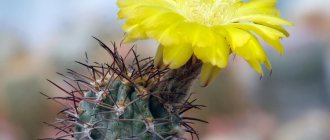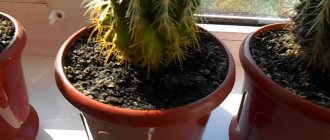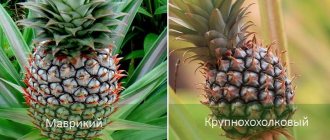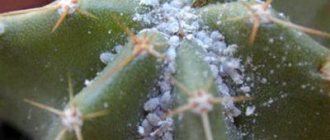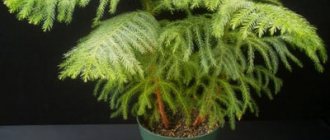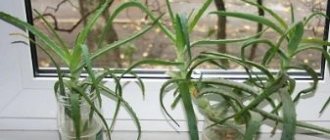The Internet is full of photos and articles about beautiful mountains, places, movies, etc. But unfortunately, so little is written about extraordinarily beautiful things. For example, about cacti. But beautiful cacti also deserve attention. The editors of most-beauty.ru decided to fill this small gap.
The family of these exotic plants includes almost three thousand species. What is surprising is that they have such a common feature as origin. They all come from America. Extreme conditions are not a problem for them at all. They store water and have a thick layer of skin, which allows them not to lose moisture and be able to stay even in very hot and dry places on the planet.
However, even among such unusual plants there are even more unique ones. In this article we will tell you about the most beautiful cacti in the world. So, let's go!
1
Astrophytum Medusa's Head
Photo credit: Resenter1/flicr
It has a unique shape and grows like the snake hair of a jellyfish. The seeds of this plant are quite large, as their diameter ranges from 3 to 6 millimeters. And the flowers have a typical color for this species - yellow with a red splash in the center.
2
Ariokarpus
A separate genus of the cactus family. It is distinguished by the absence of thorns. Mainly valued for the beauty of its flowers. They vary slightly in size, color range from yellowish to lilac. It blooms for several days in September or early October. Types of Ariocarpus: Agave, Blunt, Cracked, Flaky, Kochubeya.
Ariocarpus can be planted in river sand mixed with crushed coal and brick chips; it practically does not need humus. The plant loves diffused lighting, but for a long time it must be protected from scorching sun rays.
Water rarely when the substrate is completely dry and the temperature is high. In rainy weather, high humidity and during the dormant period, watering should be avoided. It tolerates high temperatures painlessly, but a drop after 10 degrees can destroy the plant.
Lophophora Williams or Peyote
The plant has the shape of a ball, its diameter reaches only 8 centimeters. This cactus cannot be bought and grown at home. Cultivation is prohibited by law, since Peyote contains a fairly high concentration of mescaline (a substance with a psychedelic effect). But given the fact that the Lophophora Williams cactus has long played an important role in the rituals of Indian tribes, only members of these population groups are allowed to officially use this plant.
3
Notocactus ottonis (Notocactus Otto)
Flower growers grow this species not so much for the sake of flowering, but for the interesting structure of the stem with pronounced ribs, on which hard spines look very nice.
Over time, large glossy yellow flowers appear, the diameter of which reaches 8 cm. The result is an expressive contrast against the bright green background of the stem, which adds even more attractiveness to this breed.
Hylocereus wavy
Photo source: / CC BY-SA
This species is famous for its unusually beautiful flowers. Few people perceive cacti as flowers. But, looking at Hylocereus undulate, you can change this point of view once and for all. The length of the flower reaches almost forty centimeters, and the diameter is 25 centimeters. The peculiarity of this species is that it blooms exclusively at night, each flower of the plant opens only once.
In the photo: The fruit of Hylocereus wavy, which is edible and is an exotic fruit.
The flowers emit an incredibly pleasant vanilla aroma. However, you need to take into account that the aroma is pleasant only from a distance, since when directly inhaling the smell, it can turn out to be unbearable. Pictures that can be found on the Internet do not convey all the beauty of this plant, so you can only fully enjoy its beauty in person.
4
Cereus
Powerful, tall and prickly - this is how the Cereus cactus can be described. Widely distributed in the traditional territory for cacti - in North and South America, it is capable of reaching twenty meters in height and living up to three hundred years. In addition to the spines, the cereus can also boast beautiful multi-colored flowers that bloom at night and reach a size of 25 centimeters. Like many other cacti, it is unpretentious to care, due to which it is often planted even far from home - in Europe, India and Africa. Its main difference from other relatives is its rapid growth and incredible size. In addition, it is the image of the cereus that is usually associated with the concept of “cactus”.
Pereskiopsis spathulata
It is one of the cacti that grows very quickly. It is even used as a grafting base to increase the growth rate of seedlings of slow-growing species. This species is primitive in appearance. Both thorns and leaves grow from the same place. Therefore, it is most often used from a practical point of view.
5
Aporocactus
One of the first cacti to appear in Europe was Aporocactus. Europeans quickly fell in love with it for its beautiful pink-violet flowers and the spreading nature of the climbing stems decorated with them. Capable of reaching several meters in length, these stems, covered with beautiful flowers, can add greenery and special charm to a large area of the house or garden. Since the beginning of the 21st century, aporocactus has increasingly become an element of interior landscaping, gaining popularity among designers and their clients.
Turbinicarpus subterranean
An atypical, but beautiful cactus, since only small heads can be seen above the surface of the ground, which in their shape resemble a bat. However, underground it has roots that have the ability to store water and help the plant survive periods of drought. And in the cold season, the cactus is frost-resistant due to its underground location.
6
The soil
A comfortable environment for cacti is loose, slightly acidic soil that allows air and water to pass through well. A mixture of coarse river sand, leaf humus and turf soil in equal proportions would be ideal. Stagnant water is not allowed for cacti. Therefore, it is important to make good drainage at the bottom of the pot, consisting of brick chips, expanded clay or gravel.
Blossfeldia dwarf
It is the smallest of all cacti on the planet. Blossfeldia dwarf grows from a depression located in the center of the plant, due to which a beautiful pattern appears as it grows. This plant blooms in the warm season - in summer, fertilizes itself, produces seeds. True, they are too small in size, so they often merge with the sand.
Those who decide to plant such a cactus in a pot at home will have to be patient. Since dwarf Blossfeldia is a very slow growing plant.
Home flowering cacti:
7
Video description
Watch the video for some more tips on caring for a cactus:
How to choose the right soil
In order for growing cacti to be successful, you need to select a light substrate into which air can easily penetrate. You can purchase ready-made soil mixture for cacti or make it yourself. To do this, you need to mix river sand, turf, and leaf soil. You can put expanded clay, brick chips or gravel at the bottom of the pot. They will serve as drainage.
Plant transplantation
A succulent needs to be replanted if the plant has stopped actively growing and the stem has begun to wrinkle and become dull. For some types of cacti, this procedure needs to be carried out once every two years, for others, once every five years is enough. There is no one rule for everyone; you need to monitor the condition of the succulent.
First of all, you need to protect yourself from injury. To do this, you can use gloves, or wrap the plant with thick cloth, newsprint or a washcloth. There are also special pliers for replanting cacti on sale.
Echinocactus transplant Source pocvetam.ru
The roots need to be carefully shaken out of the pot, cleaned of any remaining old soil, and dead or rotten roots removed. All cuts should be sprinkled with crushed charcoal, and the plant should be left in a dry container for the cuts to heal.
After this, you need to take a larger pot, put a layer of expanded clay on the bottom, sprinkle with a thin ball of soil, and carefully place the cactus. Using a rolled-up newspaper, you need to hold the plant strictly in the center and fill it with soil, making sure that the roots are evenly distributed in the container. Expanded clay or decorative crushed stone can be placed on top of the soil.
Plant after transplantation Source i.ytimg.com
You can water the plant after transplantation only after 15 days. All this time the plant should be in a partially darkened place.
This is how you can decorate the soil surface Source 2.bp.blogspot.com
Rhipsalis
Given this type of non-walking, this cactus will look like a regular cactus. It has the appearance of branching, succulent shoots of green-yellow color. The stems have aerial roots that are able to absorb moisture directly from the atmospheric air. The fruits of the cactus look like very small berries with a large number of black seeds. It blooms in the cold season with white, yellow or pink flowers.
9
Blue agave
Blue agave, native to Mexico, is also known as tequila agave. It is from its juice and distillate, obtained as a result of heat treatment of the agave core, that the traditional Mexican drink - tequila - is produced. Due to this, blue agave is grown in entire farms to meet the global demand for strong Mexican alcohol.
Blue agave grows in dry tropical climates, usually at altitudes above 1500 meters. Externally, agave looks not so much like a cactus, but like a hypertrophied aloe. There is persistent debate among scientists whether the agave is a cactus or a separate species, but the inhabitants of Mexico are firmly convinced that their precious blue agave is nothing more than a cactus. An interesting fact is that in Mexico, cacti serve not only as raw materials for the production of alcohol, but also replace traditional Christmas trees during the New Year celebrations.
Echinopsis
The most common among cacti grown at home. It is completely unpretentious and is a very diverse species in its shapes and sizes. It is popular for its beautiful and large flowers. The petals can be arranged in several rows and are colored in shades of white, yellow, pink, orange and purple. The plant blooms starting in spring, flowering can last up to six months.
10
Sulcorebutia and Rebutia
Miniature, spherical, papillary or ribbed members of the cactus family bloom profusely in spring or early June.
Their appearance is similar to mammillaria, however, luxurious rebutia flowers of various colors appear not at the top, but from the sides or bottom of the trunk. Create pictorial compositions.
In their homeland in Bolivia and Argentina, they grow in grassy crevices of high mountain rocks.
Epiphyllum
It blooms mainly in the warm season and has beautiful and massive flowers of various shades, the diameter of which is ten centimeters and sometimes exceeds it. Even by growing a cactus at home in a pot with artificial cross-pollination of flowers, you can get such large fruits, the pulp of which is edible and has a sweet pineapple-strawberry taste.
11
Carmine Cob (Echinopsis backebergii)
Carmine Cob is an ideal indoor cactus, growing no more than 15 cm and blooming with beautiful pink and purple flowers. It needs to be watered regularly when grown, and when mature it requires full sun. It is also extremely frost-resistant, withstanding temperatures as low as -12 °C. It is native to certain parts of southern Peru and eastern Bolivia.
Mammillaria
Small plants with shoots resembling clubs. Their peculiarity lies in their characteristic structure - in the form of numerous papillae, which can grow to form colonies.
Therefore, such a plant should be planted in wide and flat pots. They have a highly variable variety of flower colors that usually bloom in March, forming a crown around the top of the stem.
14
What are there
All home plantings, regardless of size and shape, are united by common characteristics. They have no leaves, and the fleshy stems are thickened. Regardless of whether the surface is spherical or oblong, it absorbs light perfectly. With proper care, flowering specimens will delight household members with attractive flowers every year.
There are a huge number of varieties of “domestic thorns”. All of them are divided into the following main types:
- round;
- flat;
- blooming;
- without thorns;
- elongated and many others.
Specialists are attracted by the strict but bizarre shape of the trunk, a variety of spines that can be soft and hard, delicate or bright flowers that rarely appear, and unsurpassed vitality even in extreme conditions. Species such as Trichocereus, Echinopsis, Gymnocalycium and many others are very popular.
Based on the botanical classification, the following categories are distinguished:
| Kinds | Description |
| Peireskiaceae | Belongs to the category of the most ancient and primitive. Properties are similar to deciduous representatives. The composition includes a single genus - Pereskia. Representatives have regular full leaves. The stems are not succulent. The flowers assume an upper or lower ovary, of a single type or collected in tassels. Habitat: savannas, moist equatorial forests, tropical deciduous woodlands of the Caatinga. |
| Mauchiaceae | They are distinguished by their originality. They are considered a subfamily of Opuntiaceae. They consist of two species and one genus. Representatives have small triangular green leaves, the length of which reaches a maximum of 1 cm. The shoots are small and cylindrical. Unlike prickly pears, they lack glochidia. They grow slowly. They are not afraid of low temperatures. Flowering practically does not occur. |
| Opuntiaceae | They are distinguished by clearly noticeable reduced leaves that flaunt on young shoots. As they grow older, they disappear. In their place, needle-like miniature spikes are formed, sharp and hard, with notches over the entire surface. |
| Cactaceae | This includes the rest of the family. They lack glochidia. The sprouts are spherical or cylindrical and have two cotyledons. Stems can be leaf-shaped or whip-shaped. The variety of shapes is impressive. |
Taking into account external characteristics, they are divided into the following classes:
- Shrubs. The main representative is considered to be Hylocereus. The genus includes more than 20 species. Habitat: equatorial forests. They are called forest representatives. Stems of various green tones - from light to dark. The shoots are long and creeping. The flowers are white, funnel-shaped. The spines are 0.1 to 1 cm long and occur in the form of needles or bristles. Aerial roots, in large quantities.
- Herbaceous. Habitat: flat terrain. The stems are flat and round. The spines are faint or pubescent. The color is light or rich green. The most popular is the genus Mammillaria. They occupy vast areas of wildlife. They are found on sea coasts and on the slopes of chalk mountains. Small size. The stem is cylindrical or spherical. There is no ribbing.
- Tree-like. The tallest and largest representatives with an erect stem and lateral shoots. The maximum height is 30 meters. A prominent representative is Cereus. The stem is long, cylindrical. The trunk is powerful, the root system and crown are developed. The ribbed stem is green with an interesting blue and covered with brown, gray or black spines. The flowers are white-green or pink. An ideal option for creating alpine slides.
- Liana-like. They are distinguished by soft, flexible ampelous shoots. Outwardly they resemble vines. The genus is represented by Selenicereus. Grows in equatorial tropical forests. The form can be terrestrial, lithophytic, epiphytic. They cling to nearby supports using aerial roots. Shoots can reach a length of 12 meters and a thickness of 3 centimeters.
Subterrania parody
This species is reputedly almost entirely hidden under the soil (in its habitat) and is extremely difficult to find in the wild unless it is in flower.
The stem of the cactus has a spherical shape (sometimes slightly elongated vertically) and rarely branches. Size: 6-12 cm in diameter.
With proper care, this cactus will delight you with its pleasant blooms.
15
Cleistocactus
Cleistocactus is a flowering cactus, tall and slender, usually growing in clumps. It is endemic to mountain ranges in the South American countries of Bolivia, Uruguay, Argentina and Peru. Grows best in well-drained substrate and requires more frequent watering in summer. This species can grow up to 1.2 m in length depending on the subspecies, and tends to attract hummingbirds.
Selenicereus grandiflora
Selenicereus grandiflora is a species of cactus native to the Antilles, Mexico and Central America. This species is commonly called the Night Queen, although the term is also used for other species. The flowers of this plant are large, up to 30 cm in diameter. They have a pleasant vanilla scent and, as you can see, are very beautiful.
Creeping devil (Stenocereus eruca)
The creeping devil is a long, tubular succulent that contains an organic psychoactive substance called mescaline, as well as an organic subgroup of steroids called sterols. They have light green bodies and usually grow horizontally, making them a great addition to the garden. This species requires sandy soil and produces white flowers. It is endemic to the central Pacific coast of Baja California in Mexico.
conclusions
There are many different types of cacti on the planet. Each of them is unique in its own way and is able to endure the harshest climatic conditions to give a unique beauty in a place where no other plant can do so.
The editors of most-beauty.ru ask you to write in the comments which beautiful cacti, in your opinion, should also be on this list.
Editor's note: This article has been updated since its original publication in October 2022.
Features of growing cacti at home
Cacti in the wild are found primarily in deserts and are able to survive in extreme conditions. They tolerate drought, temperature changes, and bright sunlight well. All cacti can be classified as succulent plants. Cacti are able to accumulate liquid in their tissues and use it when a dry period occurs.
Such plants successfully survive in conditions of temperature changes up to 40 degrees, lack of moisture and infertile sandy or rocky soil.
Cactus in the wild Source mandarin-shop.ru
Most varieties of cacti have long been cultivated, and there are a large number of hybrids that are not adapted to life in nature. Decorative cacti can be combined into various compositions.
Even an inexperienced gardener can achieve active growth and lush flowering, since cacti do not need to be regularly watered, pruned, replanted or sprayed. At the same time, do not forget about protection when working with succulents. To do this, you need to use gloves or wrap the stem with old newspapers.
You won’t be able to pick up this succulent without protection Source autogear.ru
It is also worth taking into account that the most beautiful cacti for the home are quite expensive. To create a composition, you can use different types of plants, and mature and expensive specimens should be used as the center of the composition or as a single plant.
Absolutely all types of cacti bloom in natural conditions. But on the windowsill or in the winter garden, flower buds are produced mainly by the following species: Cereus, Chamecereus, Mammillaria, Frailea, Echinopsis, Epiphyllum, Rebutia, Phyllocactus, Wiloxia, Astrophytum, Zygogcactus. It is much easier to create favorable conditions for these types of plants. It is also worth remembering that some types of succulents emit a rotten meat aroma when flowering. This is especially true for forest cacti.
Many succulents delight not only with their beautiful appearance, but also with their abundant flowering Source pro2-bar-s3-cdn-cf1.myportfolio.com
Ferocactus
Ferocactus is part of the large Cactus family. Its natural habitat is quite extensive - from North America, Mexico to South and South-West America. There are a lot of species of Ferocactus, we will note just a few that are the most convenient for breeding, even for beginners: Acanthus, Coloratus, Broad-needle, Ford, Imeri, Porcupine, Powerful.
The plant loves the sun both in summer and winter. Therefore, if there is a place for the cactus on the north window, then it will need lighting on winter evenings.
Also read: Bacopa - flowering plant for home and garden
If the soil is selected correctly, then in spring and summer you need to water as soon as the soil substrate is completely dry; during the dormant period, watering is reduced even more. Water with soft water: rain or melt water, warmed to room temperature. You can use filtered water.
Aztekium
The genus Aztecium from the cactus family is represented by only two species - Hinton and Ritteri. A slow growing plant, in summer it blooms with small flowers on short peduncles. The fleshy stem has deep ridges, but practically no thorns.
A very light-loving plant, in dry weather in summer, it feels great outdoors, only in the midday hours it needs a little shade. High temperatures will not harm Aztecium; for winter rest you need to reduce the temperature to 10-12 degrees Celsius.
In spring and summer, water with warm water once every two weeks; in hot weather, you can take a shower. Since Aztekium is planted in a very loose substrate, the water that has collected in the pan must be drained. During the dormant period, it is not recommended to water the succulent.
